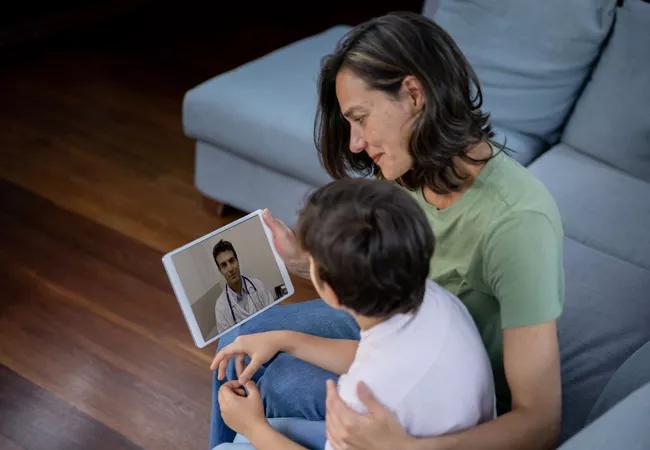Barriers to access and innovations on the horizon

The expansion of telehealth services necessitated by the COVID-19 pandemic positively shifted access to developmental and behavioral pediatric (DBP) care. But variable insurance coverage of telehealth services and other barriers to care within the field, like physician shortages, are cause for concern.
Advertisement
Cleveland Clinic is a non-profit academic medical center. Advertising on our site helps support our mission. We do not endorse non-Cleveland Clinic products or services. Policy
In this relatively new and growing field, improving patients’ access to care is essential, says Carrie Cuffman, MD, a developmental-behavioral pediatrician at Cleveland Clinic Children’s Hospital for Rehabilitation (CCCHR).
In a recent interview with Consult QD, she discussed opportunities and challenges facing the field, her professional journey to the pediatric subspecialty, and much more.
Overall, telehealth has broadened our ability to provide services to children. Specifically for children with autism or anxiety, seeing a provider from the comfort of their own home is often much easier and less disruptive for the child; they don’t have to go to an unfamiliar and possibly frightening doctor’s office for an appointment. This can result in a calmer child throughout the appointment.
Other benefits include increased ease of getting to appointments for quick check-ins, such as medication checks. Telehealth has also made caring for children who live further away much easier, as physically coming to the appointment is no longer a barrier to care.
Regarding autism evaluations, specifically, there is an ongoing conversation within our field about how we can utilize telehealth to provide more timely diagnoses for children, particularly in low-resource areas where it can be difficult to find any provider within a reasonable distance to provide the evaluation. The best known of these currently is the TELE-ASD-PEDS, coming from a team at Vanderbilt Kennedy Center, which is an autism evaluation tool for children under the age of 3.
Advertisement
If a child does not prefer to interact via a screen, it can be difficult to assess certain aspects of development, such as their ability to engage in conversation. We also need patients to be present in the office at times to check vitals if they are on certain medications and to complete a full physical exam, which is most important at initial evaluation visits and before starting certain medications.
We struggled to diagnose young children at the beginning of the pandemic due to a lack of appropriate tools for doing so during the initial lockdown phase when all patients were being seen virtually. For school-age children, particularly those with special needs, virtual learning has been incredibly difficult. Schools were and continue to be overwhelmed by the switch to virtual learning as well as the additional demands the pandemic created, such as monitoring and reporting cases. The inadequacy of virtual learning, particularly at the start of the pandemic, has made it more difficult for schools to distinguish between children with true learning disabilities and those who are behind due to a lack of adequate instruction. As a result, special education services are currently in high demand, and it can be very difficult for children to access needed support.
Our field is a relatively young and growing one with many opportunities for positive change. Focusing on autism alone, many varied strategies are being implemented to improve the screening and diagnosis of all children with autism. This includes the TELE-ASD-PEDS work coming out of Vanderbilt that I previously mentioned, as well as groups exploring the use of mobile screening apps to identify autism and help promote appropriate diagnosis across all patient populations.
Advertisement
Improving access to care is another big challenge facing our field. There are a small number of board-certified developmental-behavioral pediatricians (DBPs) compared to the number of children in the United States who could potentially benefit from our care. It is estimated that about 1 in 6 children have a developmental or behavioral problem, but across the United States there are only about 800 practicing board certified/eligible DBPs. There are often long waits for patients to get in to see a DBP. There are 48 fellowship spots each year (which means potential for 48 new DBPs yearly), but each year only about half of these are filled.
To address this immense gap between the number of providers compared to the number of children who potentially could benefit from our care, a range of strategies is being suggested and trialed at various institutions and includes the use of advanced practice nurse practitioners in the care model, partnerships with general pediatricians/”mini-fellowships” for interested general pediatricians, and increasing fellowship recruitment by fostering an early interest in the field (as early as medical school).
Advertisement
Advertisement

Integrated care model reduces length of stay, improves outpatient pain management

A closer look at the impact on procedures and patient outcomes

Experts advise thorough assessment of right ventricle and reinforcement of tricuspid valve

Study also finds that 26% of children with cancer have mutations in DNA repair genes

A closer look at current uses and future opportunities

Experts are challenging the one-size-fits-all paradigm

Quality improvement project addresses unplanned extubation

Cardiac imaging substudy is the latest paper originating from the VANISH trial